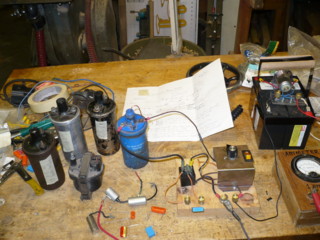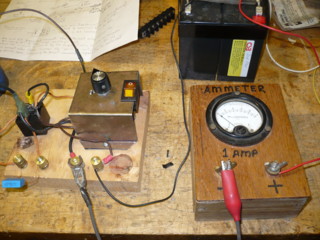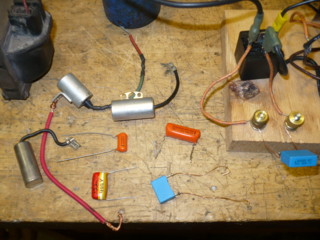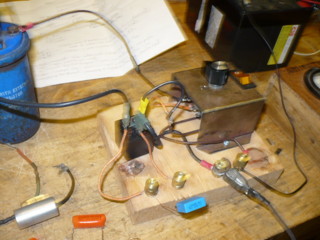|
| More Measurements - Ignition Box |
| Author |
Message |
    
miro forest
Senior Member
Username: miro
Post Number: 811
Registered: 11-2001

| | Posted on Sunday, April 05, 2015 - 05:00 pm: | 




|
Now that spring is finally coming on, and many of us are going to be going out in boats with old marine engines, and we sometimes forget the 80% of carburetor problems are electrical,
I decided to continue with the exploration of the modern version of the buzz coil.
I've shown the diagram before, as has Ernie and others.
But, I wanted to see what effect the change in value of the capacitor ( condenser) and resistor might have.
I built the test arrangement that lets me test cols, capacitors and to optimize the resistor for spark and battery current drain.
Without the ignition coil, the automotive relay draws about .050 Amps so practically speaking it's not significant.
From the pictures you can see that I tested a number of different capacitors. They ranged from .0022 mfd to .11 mfd. I was able to test higher values by connecting several capacitors in parallel.
Here's what I found:
Capacitor value as low as .039 mfd will work OK. Below that the spark becomes weak or non-existent.
At the other end , I found there was no improvement in the spark, when I had as much as .41 mfd. SO a .1 mfd or something around that value can be used very nicely.
BUT - here's the big but - make sure the voltage rating is 600 V. The blue capacitors in the pictures are mylar film capacitors. They cost about $1.00 Cdn, in onesies and twosies. In volume the cost less than 25 cents. They are my preferred item.
These capacitors can be obtained from electronics supply stores, and are a lot less expensive than the tubular metal capacitors many people use and which are getting more difficult to find.
I have a 10 ohm variable resistor in the circuit. I found that using a 3 ohms in series with the primary of the ignition coil gave a very good spark, while limiting the current drain to about .8 A ( 800 MiliAmps).
Most Model T coils draw at least 1.2A and some are as high as 1.7 A, or about double the current, which means you are draining 4X the power out of the battery, with no better spark.
Some of the coils I tested would work well with current as low as 500 mA.
I also tested a couple of more modern coils and they worked fine with the buzz coil set up, same capacitor ( .11 mfd, 600V) and resistor ( 3 ohm).
At 12 V and .8 A, the spark is drawing about 7.5 Watts in the primary.
Assuming about 20,000 V secondary, the current in the spark is in the order of 10 - 15 microAmps.
The buzz frequency is in excess of 1500 HZ , which means that when starting you get 7 to 10 sparks in the gap of the spark plug, which increases the likelihood that the engine will fire.
Miro



 |
|
|
|


|


